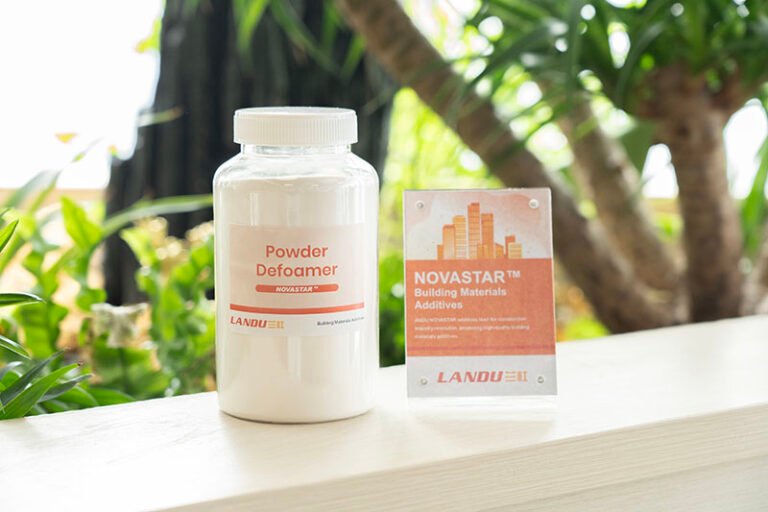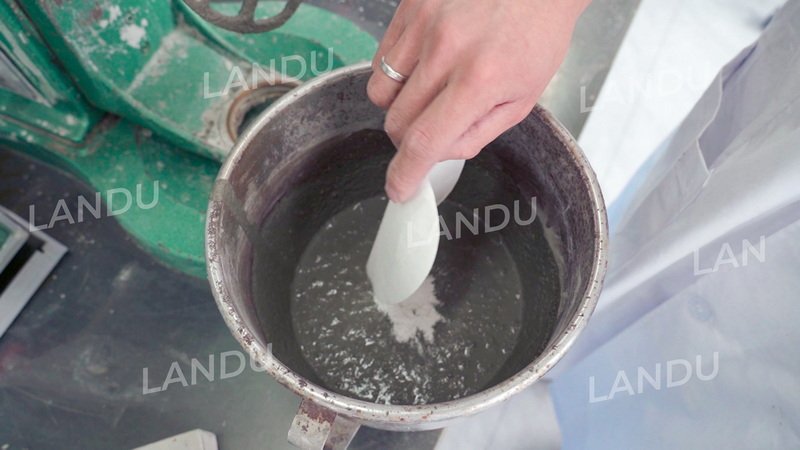Executive Summary
Methyl hydroxyethyl cellulose (MHEC) stands as a versatile, non-charged cellulose derivative extensively employed to regulate moisture preservation, thickness, and handling traits in contemporary building and decorative solutions. Through concurrent oversight of liquid flow and flow dynamics, MHEC secures wet blends, boosts usability, prolongs usability periods, and elevates exterior excellence in formulations rooted in cement and plaster, alongside aqueous coatings. The MHEC lineup from LANDU is crafted for dependable swelling and uniform lot-to-lot flow behavior, allowing developers to achieve rigorous benchmarks for usability duration, droop prevention, spreading sensation, compactness, and attachment while curbing site inconsistencies.
This in-depth piece delves into MHEC’s operations at granular and structural scales; the ways its chemical composition and density category affect solidification threshold, ion endurance, and texture; and approaches to pick, measure, and merge MHEC with supplementary components across five usage groups:
- Coatings and exterior finishes
- Binders and slab attachments
- Thin layers and surface fillers
- Seam sealants
- Latex varnishes
You’ll encounter actionable advice on preparation and validation routines, environmental and base adaptations, collaboration with re-dispersible polymeric dusts (RDP), typical malfunction types with remedies, rollout blueprints, and economic value analyses. The objective is straightforward: transform MHEC’s molecular properties into dependable, reproducible site outcomes.
1) Defining MHEC and Its Importance
MHEC arises from attaching methyl and hydroxyethyl units to cellulose. These attachments convert a naturally insoluble natural polymer into a liquid-dissolvable, layer-creating flow adjuster with two attributes profoundly relevant to construction substances:
- Swelling and density accumulation: Within liquids, MHEC absorbs and constructs a woven molecular framework. This setup heightens mixture density and instills a manageable initial resistance that fortifies mineral suspensions, binders, and pastes against division and seepage.
- Heat-induced solidification: With rising warmth, MHEC blends display a reversible liquid-to-gel shift at a specific solidification point. In binders and coatings laid on heated bases or during warm seasons, this fleeting solidification aids the substance in sustaining shape and opposing droop until the mineral adhesive dominates.
From these dual aspects emerge four functional contributions:
- Liquid preservation: By curbing vaporization and tempering base pull, MHEC sustains the hydration essential for cement curing or plaster crystal growth. Consequently, this yields diminished initial contraction, scarcer fine fractures, and superior early attachment formation.
- Flow oversight: MHEC confers force-responsive thinning and recoverability. Amid agitation, blends distribute, propel, or mist effortlessly; idle, framework reforms to avert settling and preserve boundary clarity.
- Slickness and handling texture: MHEC’s slender molecular layers on granule exteriors lessen rubbing, diminishing spreading effort and enhancing slide—resulting in swifter placement with tidier conclusions.
- Initial unity: Prior to full mineral adhesive hardening, MHEC adds unity and moist grip, facilitating ridging, grid incorporation, and upright accumulation sans detachment.
Why does MHEC hold such weight in an industry facing demands for speed, durability, and eco-friendliness? Consider the challenges of varying weather, inconsistent bases, and tight timelines—without a stabilizer like MHEC, defects such as cracks or uneven sets could escalate, inflating costs and environmental impact through waste.
2) MHEC’s Functionality in Cement, Plaster, and Coating Setups
2.1 Within Cement-Rooted Binders and Attachments
- Hydration regulation: Ordinary cement uses liquid in curing as the base concurrently extracts it. MHEC tempers this extraction, balancing wetness gradients across depths. This fosters thorougher curing, elevated initial robustness, firmer boundary links, and lowered rates of initial contraction fractures.
- Flow dynamics and pattern hold: In slab attachments, the blend of initial resistance and recoverable nature sustains grooved patterns, permitting even slab saturation. For exteriors and fixes, droop opposition enables thicker upright layers sans collapses, particularly at edges and indentations. Imagine applying a render on a sun-baked wall—without MHEC, the mix might slump like melting ice; with it, it clings steadfastly.
- Harmony with enhancers: Being neutral, MHEC meshes well with carboxylic acid-based flow enhancers, bubble suppressants, and gas introducers. Yet, overall gas levels may climb with abundant MHEC or vigorous stirring. Suppressant selection and addition order are vital to manage gas and uphold intended compactness. In practices, this compatibility allows lower water-to-cement ratios, boosting final strength without usability loss.
2.2 Within Plaster-Rooted Coatings and Thin Layers
- Liquid hold and hardening outline: Plaster hardens through calcium sulfate crystal formation. MHEC bolsters even hardening by curtailing early liquid drain into absorbent bases and equilibrating thermal release. Managed liquid preservation results in scarcer voids and a denser, glossier conclusion.
- Abradability and conclusion: For concluding coatings and thin applications, MHEC’s flow delivers a velvety placement and polished exterior needing minimal after-abrading; when abrading is required (e.g., seam polishing), the molecular web should avoid glassy surfaces. This is especially useful in interior finishes where smooth walls are paramount for aesthetics and paint adhesion.
2.3 Within Aqueous Latex Varnishes
- Simulated plastic behavior: MHEC offers robust low-force density for droop aversion and container steadiness, while permitting high-force thinning for tool or mist use. Outcomes include lessened spray, superior tool load, and enhanced evening.
- Layer accumulation and usage flexibility: Harmonized low- and high-force densities aid varnishes in holding layer depth on uprights sans runs while smoothing tool traces.
- Colorant suspension and preservation reliability: MHEC averts settling and liquid separation in storage, prolonging usability and guaranteeing uniform hue/coverage from initial to final application. In high-traffic architectural paints, this stability reduces waste and ensures consistent performance across large projects.
3) Variant Choice: Customizing MHEC for Environment, Makeup, and Usage
3.1 Density Variant (Chain Length Stand-In)
- Subtle density types (e.g., 300–1500 mPa·s in 2% blend): Quick swelling, lessened liquid needs, and gentle densification. Apt for propellable binders, spreadable bases, or varnishes needing lesser low-force density at fixed solids.
- Moderate density types (e.g., 2000–20,000 mPa·s): Even liquid hold and recoverability. Frequent picks for thin layers, coatings, masonry binders, and numerous slab attachments.
- Intense density types (e.g., 40,000–100,000+ mPa·s): Potent liquid preservation, marked droop aversion, and strong framework restoration. Valuable for dense exteriors, high-accumulation fixes, and droop-free attachments on outdoor fronts. Selection here can vary by region—humid tropics might favor moderate for flexibility, arid zones intense for hold.
3.2 Chemical Makeup and Solidification Threshold
- Methyl and hydroxyethyl amounts dictate solidification point and ion endurance. Marginally lower solidification points benefit warm, dry environments by aiding early upright stability in curing; higher points may safeguard usability in chillier settings. This flexibility allows tailoring to global climates, from desert constructions to temperate builds.
3.3 Swelling Pace and Granule Dimensions
- Rapid-swelling types suit brief blending rounds or small-lot site tasks. Postponed-swelling (coated) types lessen clumping in vigorous stirring or dense blends by permitting powders to saturate pre-density surge.
3.4 Cleanliness and Residue
- Reduced residue lowers blooming risks and refines decomposition. Uniform makeup and dampness levels yield foreseeable density growth and usability spans across batches.
3.5 Choosing via LANDU
- LANDU categorizes MHEC variants by density range, solidification span, swelling outline, and suggested usage. Our specialists usually suggest 2-3 options for evaluation over anticipated environmental ranges (warm/arid, mild, cool/damp), incorporating field trials for real-world validation.
4) Usage-Specific Refinement
4.1 Coatings and Exteriors (Cement/Lime/Plaster)
Aims
- Effortless spreading with lowered bounce
- Upright accumulation sans drooping
- Regulated hardening and even dehydration
- Minimal contraction fractures and solid attachment to stonework, concrete, or readied bases
MHEC’s Function
- Liquid preservation guarantees uniform hardening through coating depth and lessens pull into absorbent bricks or aged bases.
- Recoverability and initial resistance bolster sections on uprights and sustain edge lines and grooves.
- Slickness cuts spreading labor, boosting efficiency and exterior evenness.
Supporting Enhancers and Elements
- Lime amounts boost usability and conclusion; MHEC permits lime cuts in certain setups sans texture loss.
- Gas introducers enhance cold-cycle endurance in outdoor exteriors; equilibrate gas with suppressant to safeguard robustness.
- Threads (natural, synthetic, vitreous) add fracture oversight; MHEC holds threads evenly distributed.
Standard Initial Measure (by Dry Blend Mass)
- 0.15–0.40% in cement/lime or plaster exteriors and coatings. Escalate to upper for high-pull bases, warm/arid weather, or denser layers.
Method Remarks and Validation
- Premix MHEC dry with subtle bulks to evade local excess. Add powder to liquid under agitation.
- Grant short pause (2–5 minutes) for swelling; re-agitate to final state.
- Site verifications: settling or taper flow, droop/upright grip, exterior look post-initial hardening, and fracture chart after 1-2 days.
Typical Problems and Fixes
- Drooping on uprights: Slightly elevate density type, boost MHEC measure in range, or lessen liquid need via refined aggregate spread.
- Spreading pull or ripping: Confirm suppressant match, check swelling duration, or cut gas levels.
- Fine exterior fractures: Amp liquid hold (type or measure) and confirm drying (spray or managed moisture); ponder fine threads.
4.2 Binders and Slab Attachments
This group encompasses stonework binders, thin-layer attachments, and medium-layer or oversized slab attachments.
Aims
- Reliable usability and mix lifespan
- Droop/slip aversion on upright placement
- Prolonged usability time and extended repositioning
- Robust attachment post-testing (liquid soak, warmth, cold cycles)
MHEC’s Function
- Liquid hold and flow oversight provide pattern stability for attachments, enabling even slab saturation and shift.
- In stonework binders, MHEC tempers brick/block pull, boosting link and cutting weak seams.
- The molecular web supplies unity and moist grip, enhancing contact on low-pull slabs and compact bases.
Collaboration with RDP and Starch Derivative
- RDP (e.g., vinyl-based or modified) heightens pull attachment, adaptability, and motion opposition. Merging with MHEC produces longer usability sans collapse and superior detachment force post-testing.
- Starch derivative refines recoverability in attachments for crisper pattern clarity and better slip aversion in warm weather.
Standard Initial Measure (by Dry Blend Mass)
- Stonework binders: 0.10–0.30% MHEC
- Thin-layer attachments: 0.20–0.60% MHEC; 2–5% RDP for superior attachment/adaptability, higher for outdoor fronts or low-pull porcelain
- Medium-layer/oversized: Toward upper MHEC span with cautious compactness oversight and bubble suppression
Method Remarks and Validation
- Lab assays: Flow surface or distribution, slip/droop assays, usability/attachment, wet compactness/gas levels.
- Site: Pattern preservation and shift to slab rear, repositioning span, and slip on uprights.
Typical Problems and Fixes
- Brief usability in warm/arid conditions: Shift to denser type or boost MHEC in range; pre-moisten absorbent bases if permitted; add shade or barriers.
- Empty-sounding slabs: Amp RDP or confirm pattern failure/shift; ensure proper tool angle and force.
- Excess gas and low compactness: Review suppressant type/measure and agitation energy; ponder postponed-swelling MHEC type.
4.3 Thin Layers and Surface Fillers (Cement- or Plaster-Based)
Aims
- Tapered-edge placement, glossy conclusion, minimal voids
- Solid attachment to cement bases and properly readied wallboard or panels
- Fracture opposition and, if needed, abradability
MHEC’s Function
- Regulates liquid loss and layer creation to form even, flaw-free skins.
- Supplies recoverability and boundary grip so tapered zones avoid curling.
- For plaster thins, MHEC tempers hardening and boosts slide.
Standard Initial Measure (by Dry Blend Mass)
- Cement-based: 0.20–0.50% MHEC
- Plaster-based: 0.10–0.40% MHEC
Supporting Elements
- Subtle bulks (e.g., calcium mineral) for gloss and abrading outline
- Minor RDP adds (1–3%) to boost attachment and unity on dense or coated bases
- Water-repellents or additives where low liquid uptake is sought
Typical Problems and Fixes
- Voids: Cut gas via matching suppressant, restrict vigorous agitation post-density, and shun over-spreading.
- Boundary lifting: Boost MHEC modestly or shift to denser type; ensure base is clean and not too arid.
4.4 Seam Sealants (Wallboard Seams, Slab Grouts, Mending)
Aims
- Steady paste with low contraction
- Simple shaping and leveling
- Fracture opposition and firm attachment over seams
MHEC’s Function
- Preserves liquid to avert early edge drying; steadies bulks and threads.
- Aids droop-free filling in upright uses and boosts unity to minimize knife tearing.
Standard Initial Measure (by Dry Blend Mass)
- 0.15–0.40% MHEC; augment with germ killers for microbe opposition in pre-mixed setups; add water-repellents for occasional damp exposure.
Typical Problems and Fixes
- Fractures in broad seams: Amp liquid hold and ponder thread strengthening; check drying and ambient moisture.
- Tough abrading: Confirm overall adhesive ratio; minor polymer cut (if RDP present) or bulk spread shift can restore equilibrium abradability.
4.5 Latex Varnishes (Architectural Layers)
Aims
- Harmonized low/high-force densities for usage flexibility
- Low tool spray and solid tool sensation
- Droop-even equilibrium and container reliability
MHEC’s Function
- Main or joint densifier to attain simulated plastic flow: high low-force density for droop oversight and container steadiness; regulated high-force density for placement.
- Boosts hue reception and cuts separation.
Standard Initial Measure (as Delivered, on Total Blend)
- 0.10–0.40% MHEC, based on pigment load, adhesive type, and sought low/high-force equilibrium. In moderate-to-high pigment interior flats, MHEC often acts as core densifier; in low-pigment premium varnishes, merge with other densifiers to refine flow/even.
Processing and Validation
- Grinding stage: Add part MHEC to build base density andsteady colorant spreads.
- Final mix: Adjust ultimate low/high-force (e.g., 80–110 for many interior flats) and (e.g., 0.9–1.3 for droop/even equilibrium). Assess droop score, evening grade, and spray in norm assays.
5) Collaboration with Re-Dispersible Polymeric Dusts (RDP) and Other Enhancers
- With RDP in binders and fillers: MHEC’s liquid hold and regulated flow aid RDP granules in re-spreading well, merging, and forming seamless molecular layers in the mineral structure. Results include superior pull attachment (fresh and tested), enhanced adaptability, and better fracture opposition.
- With starch derivative in attachments and exteriors: Starch sharpens recoverability, amps framework rebound, and boosts droop aversion; MHEC stays the primary densifier/liquid preserver.
- With flow enhancers: MHEC supplies structure and liquid hold while enhancers cut liquid needs; balance to hit goal movement at lower ratios.
- With bubble suppressants: Pick oil or silicone types matching alkaline setups and MHEC. Add promptly and tweak measure to avert voids and keep design compactness. This synergy is key in high-air systems like aerated renders.
6) Preparation, Swelling, and Quality Oversight Fundamentals
6.1 Scattering and Swelling
- Order: Premix MHEC with subtle bulks to boost scattering. Add powder to liquid under stirring, not opposite. For postponed types, permit saturation pre-vigorous agitation.
- Swelling duration: Allocate short pause (2–10 minutes) for density accumulation; re-agitate to final. For varnishes, pre-dissolve MHEC or mix under sufficient force to avoid lumps.
6.2 Gas and Bubble Oversight
- Limit vigorous stirring to essentials. Assess suppressant type/measure and add promptly. Excess gas heightens apparent density and forms voids or frail exteriors.
6.3 Validation Points for Received MHEC
- Dampness level and bulk compactness: Impact measuring and scattering.
- Density (e.g., 2% blend at 20°C): Assures lot uniformity.
- Makeup degree and solidification threshold: Direct environmental fit.
- Granule size/swelling outline: Affect clumping and blend duration.
- Residue amount: Links to blooming risk and decomposition.
6.4 Validation on Wet Blends
- Binders/exteriors: Flow or distribution, compactness/gas levels, droop/upright grip, usability, early exterior look.
- Slab attachments: Slip/droop, pattern stability and shift, usability, pull attachment post-testing.
- Thin layers/fillers: Blade pull, void count, tapered grip, abradability (if needed).
- Varnishes: Low/high-force density, droop score, evening, spray, hue reception, preservation reliability.
7) Environment, Base, and Cyclic Adaptations
- Warm, arid conditions: Boost MHEC measure or up one density type for potent liquid hold and longer usability. Offer sun/wind shelter and pre-moisten high-pull bases if allowed.
- Cool, damp conditions: Shun over-hold delaying hardening/drying. Ponder down one density type or cut measure. Ensure sufficient air swap for indoor drying.
- High-pull or warm bases: Pre-treat with sealers or light spray if permitted; slightly amp MHEC to retain moisture in the layer.
- Dense, low-pull bases (e.g., existing slabs, sealed concrete): Pair MHEC with RDP and attachment boosters; control gas to maximize contact. Seasonal shifts can affect performance by 15-20%; proactive tuning maintains consistency.
8) Eco-Friendliness and Economic Value
- Reduced redo: By steadying placement and curbing flaws (droop, fractures, voids), MHEC lowers waste and recalls, trimming built-in emissions in fixes.
- Liquid efficiency: Superior hold means fewer added liquids for usability and less corrective work, aiding builders in meeting use limits.
- Power and timing: More foreseeable drying/hardening cuts over-drying or heat rushes, saving power and enabling dependable team scheduling.
- Resource refinement: With apt MHEC, developers can at times cut lime or expensive co-adhesives sans sacrificing sensation or conclusion. In green builds, this aligns with low-carbon goals.




